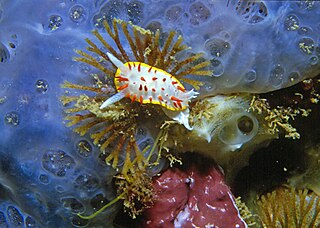Related Research Articles

Bryozoa are a phylum of simple, aquatic invertebrate animals, nearly all living in sedentary colonies. Typically about 0.5 millimetres long, they have a special feeding structure called a lophophore, a "crown" of tentacles used for filter feeding. Most marine bryozoans live in tropical waters, but a few are found in oceanic trenches and polar waters. The bryozoans are classified as the marine bryozoans (Stenolaemata), freshwater bryozoans (Phylactolaemata), and mostly-marine bryozoans (Gymnolaemata), a few members of which prefer brackish water. 5,869 living species are known. At least two genera are solitary ; the rest are colonial.

Entoprocta, or Kamptozoa, is a phylum of mostly sessile aquatic animals, ranging from 0.1 to 7 millimetres long. Mature individuals are goblet-shaped, on relatively long stalks. They have a "crown" of solid tentacles whose cilia generate water currents that draw food particles towards the mouth, and both the mouth and anus lie inside the "crown". The superficially similar Bryozoa (Ectoprocta) have the anus outside a "crown" of hollow tentacles. Most families of entoprocts are colonial, and all but 2 of the 150 species are marine. A few solitary species can move slowly.

The International Code of Nomenclature for algae, fungi, and plants is the set of rules and recommendations dealing with the formal botanical names that are given to plants, fungi and a few other groups of organisms, all those "traditionally treated as algae, fungi, or plants". It was formerly called the International Code of Botanical Nomenclature (ICBN); the name was changed at the International Botanical Congress in Melbourne in July 2011 as part of the Melbourne Code which replaced the Vienna Code of 2005.
Blanche Muriel Bristol was a British phycologist who worked at Rothamsted Research in 1919. Her research focused on the mechanisms by which algae acquire nutrients.
Barbara Leigh-Hunt is an English actress. Her numerous theatre credits include Broadway productions of Hamlet (1958) and Sherlock Holmes Justice (1973) (1974), and she won the 1993 Olivier Award for Best Supporting Actress for the National Theatre production of An Inspector Calls. Her film appearances include Frenzy (1972), Henry VIII and His Six Wives (1972), Bequest to the Nation (1973) and Billy Elliot (2000).

The International Bryozoology Association (IBA) is a professional association with international membership specialising in research of the phylum Bryozoa.

Bugula is a genus of common colonial arborescent bryozoa, often mistaken for seaweed. It commonly grows upright in bushy colonies of up to 15 cm in height.

Jellyella is a genus of bryozoans in the family Membraniporidae.

The phylogenetic classification of invertebrates remains a work-in-progress. The taxonomy of commonly fossilized invertebrates combines both traditional (old) and modern (21st-century) paleozoological terminology.
For the former New Zealand politician, see Helen Duncan (politician). For the Scottish Medium, see Helen Duncan.
Libinia ferreirae is a species of tropical spider crab in the family Epialtidae. It is found on the seabed in shallow waters off the Atlantic coast of South America.

Ernst Gustav Gotthelf Marcus was a German zoologist, former occupant of the chair of zoology at the University of São Paulo from 1936 to 1963, and co-founder of the Oceanographic Institute of the University of São Paulo.
Bryozoology is a branch of zoology specializing in Bryozoa, commonly known as moss animals, a phylum of aquatic invertebrates that live in clonal colonies.
Madeleine Alberta Fritz was a Canadian palaeontologist. She was a professor at the University of Toronto, where she taught vertebrate studies in the department of Geology. Fritz's writing on the fossil Bryozoa along with her research on the stratigraphy of Toronto and the surrounding areas were major contributions to the geological field.

Eliza Maria, Lady Gordon-Cumming was a Scottish aristocrat, horticulturalist, palaeontologist and scientific illustrator. Lady Cumming collected and studied Devonian fish fossils from the Old Red Sandstone of Morayshire, Scotland. She amassed a large and well-known collection which she illustrated, along with her daughter Lady Anne Seymour. Lady Cumming worked with other palaeontologists and geologists of the time including Louis Agassiz, William Buckland and Roderick Murchison.
Joan Marion Crockford-Beattie was an Australian geologist and palaeontologist who specialised in Permian bryozoan faunas.
Paleontology or palaeontology is the study of prehistoric life forms on Earth through the examination of plant and animal fossils. This includes the study of body fossils, tracks (ichnites), burrows, cast-off parts, fossilised feces (coprolites), palynomorphs and chemical residues. Because humans have encountered fossils for millennia, paleontology has a long history both before and after becoming formalized as a science. This article records significant discoveries and events related to paleontology that occurred or were published in the year 2015.
Bryosartor is a genus of bryozoan described by Gordon and Braga in 1994. The only species is Bryosartor sutilis. It belongs to the family Catenicellidae. No subspecies are listed. It is a marine bryozoan known from New Caledonia.
Callopora lineata is a species of colonial bryozoan in the family Calloporidae. It is found on rocky shores in the Atlantic Ocean and the Mediterranean Sea.
June Rosa Pitt Ross was an Australian geologist, palaeontologist and biologist. She was amongst the first women to obtain a PhD in Australia, and one of the few women of the time to build a successful career in academia.
References
- ↑ Torrens, Hugh S.; Winston, Judith E. (2002). "Eliza Catherine Jelly (28th September 1829 – 3rd November 1914): pioneer female bryozoologist" (PDF). Annals of Bryozoology.
- ↑ Smith, Abigail (2008). "Women in the International Bryozoology Association, 1965 to 2001" (PDF). Annals of Bryozoology. Dublin: International Bryozoology Association.
- 1 2 Conference, International Bryozoology Association (2002). Annals of Bryozoology: Aspects of the History of Research on Bryozoans. International Bryozoology Association. ISBN 978-0-9543644-0-3.
- ↑ P, Jennifer (2023-03-08). "Eliza Catherine Jelly, a Pioneering Woman in Science". Blogs from the Natural History Museum. Retrieved 2023-03-08.
- ↑ "Tervia jellyae Harmer, 1915". www.gbif.org. Retrieved 2022-07-18.
- ↑ Taylor, Paul D.; Monks, Neale (1997). "A New Cheilostome Bryozoan Genus Pseudoplanktonic on Molluscs and Algae". Invertebrate Biology. 116 (1): 39–51. doi:10.2307/3226923. ISSN 1077-8306. JSTOR 3226923.